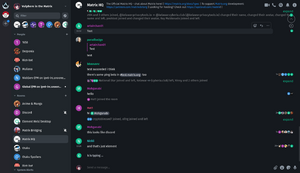Element (Instant Messaging)
 From Handwiki
From Handwiki  | |
 Screenshot of Element 1.8.1 | |
| Other names |
|
|---|---|
| Original author(s) | Vector Creations Limited[1] |
| Developer(s) | New Vector Limited[3] trading as Element |
| Initial release | July 2016 (Beta) |
| Written in | JavaScript, ObjectiveC, Swift, Java, Kotlin |
| Platform | Windows, macOS, Linux, Android, iOS, Web platform |
| Available in | 25 languages[4] |
List of languages Basque, Bulgarian, Chinese (Simplified), Chinese (Traditional), Czech, Dutch, English (UK), English (US), Esperanto, Finnish, French, German, Hungarian, Italian, Korean, Latvian, Norwegian, Polish, Portuguese (Brazil), Romanian, Russian, Serbian, Slovak, Spanish, Swedish | |
| Type | VoIP communications, instant messaging, Videoconferences,[5] social media, and other App Integrations |
| License | Apache-2.0[6] |
| Website | element |
Element (formerly Riot and Vector[9]) is a free and open-source software instant messaging client implementing the Matrix protocol.[10]
Element supports end-to-end encryption, groups and sharing of files between users. It is available as a web application, as desktop apps for all major operating systems and as a mobile app for Android and iOS.[5][11][12][non-primary source needed]
History
Element was originally known as Vector when it was released from beta[1][2] in 2016.[13] The app was renamed to Riot in September of the same year.[14]

In 2016 the first implementation of the Matrix end-to-end encryption was implemented and rolled out as a beta to users.[15] In May 2020, the developers announced enabling end-to-end encryption by default in Riot for new non-public conversations.[16]
In April 2019, a new application was released on the Google Play Store in response to cryptographic keys used to sign the Riot Android app being compromised.[17]
In July 2020, Riot was renamed to Element.[18]
In January 2021, Element was briefly suspended from Google Play Store in response to a report of user-submitted abusive content on Element's default server, matrix.org.[19][20] Element staff rectified the issue and the app was brought back to the Play Store.[20]
Technology
Element is built with the Matrix React SDK,[21] which is a React-based software development kit to ease the development of Matrix clients. Element is reliant on web technologies and uses Electron for bundling the app for Windows, MacOS and Linux. The Android and iOS clients are developed and distributed with their respective platform tools.
On Android the app is available both in the Google Play Store[22] and the free-software only F-Droid[23] Archives, with minor modifications. For instance, the F-Droid version does not contain the proprietary Google Cloud Messaging plug-in.[24]
Features
Element is able to bridge other communications into the app via Matrix,[10] including IRC, Slack, Telegram, Jitsi Meet and others.[25][26] Also, it integrates voice and video peer-to-peer and group chats via WebRTC.
Element supports end-to-end encryption (E2EE) of both one-to-one and group chats.[5][non-primary source needed][26]
Reception
Media compared Element to Slack,[1][2] WhatsApp[2] and other instant messaging clients.[27]
In 2017, German computer magazine Golem.de called Element (then Riot) and Matrix server "mature" and "feature-rich", but criticized its key authentication at the time to be not user-friendly for communicatees owning multiple devices. A co-founder of the project, Matthew Hodgson, assured the key verification process was a "placeholder" solution to work on.[27] In 2020, Element added key cross-signing to make the verification process simpler, and enabled end-to-end encryption by default.[16]
See also
- Matrix
- IRC
- Rich Communication Services (RCS)
- Session Initiation Protocol (SIP)
- XMPP
References
- ↑ 1.0 1.1 1.2 1.3 "Riot wants to be like Slack, but with the flexibility of an underlying open source platform" (in en-US). TechCrunch. https://techcrunch.com/2016/09/19/riot-wants-to-be-like-slack-but-with-the-flexibility-of-an-underlying-open-source-platform/.
- ↑ 2.0 2.1 2.2 2.3 "Open Source und verschlüsselt: Das steckt hinter dem Slack-Rivalen Riot" (in de). t3n News. https://t3n.de/news/open-source-slack-rivalen-riot-748095/.
- ↑ "Copyright policy". https://element.io/copyright.
- ↑ "matrix-org/matrix-react-sdk" (in en). https://github.com/matrix-org/matrix-react-sdk/blob/master/README.md.
- ↑ 5.0 5.1 5.2 "Features | Riot". https://about.riot.im/features.html.[primary source]
- ↑ "Riot.im License". https://github.com/vector-im/riot-web/blob/master/LICENSE.
- ↑ "Releases · vector-im/element-web" (in en). https://github.com/vector-im/element-web/releases/.
- ↑ "Releases · vector-im/element-web" (in en). https://github.com/vector-im/element-web/releases/.
- ↑ Paul, John. "Decentralized Messaging App Riot Rebrands to Element" (in en-US). https://itsfoss.com/riot-to-element/.
- ↑ 10.0 10.1 "Riot: A Distributed Way of Having IRC and VOIP Client and Home Server". https://itsfoss.com/riot-desktop/.
- ↑ F-Droid. "Element (Riot.im)". https://f-droid.org/en/packages/im.vector.app/index.html.en.
- ↑ PrivacyTools. "Real-Time Communication" (in en). https://www.privacytools.io/software/real-time-communication/.
- ↑ Riot.im (9 June 2016). "Say Hello To Vector!". https://medium.com/@RiotChat/say-hello-to-vector-2d33b23a787.[primary source]
- ↑ Riot.im (19 September 2016). "Let's Riot!". https://medium.com/@RiotChat/lets-riot-f5b0aa99dc8e.[primary source]
- ↑ Riot.im (21 November 2016). "Riot releases end-to-end encryption: get ready to chat securely!". https://medium.com/@RiotChat/exciting-new-riot-release-get-ready-for-chatting-securely-acc93ecfe0a.[primary source]
- ↑ 16.0 16.1 Hodgson, Matthew (6 May 2020). "Riot Web 1.6, RiotX Android 0.19 & Riot iOS 0.11 — E2E Encryption by Default & Cross-signing is here!!". https://blog.riot.im/e2e-encryption-by-default-cross-signing-is-here/.[primary source]
- ↑ "Riot.im Android security update". https://medium.com/@RiotChat/riot-im-android-security-update-2b3f655ad739.[primary source]
- ↑ Le Pape, Amandine (15 July 2020). "Welcome to Element!". https://element.io/blog/welcome-to-element/.[primary source]
- ↑ Amadeo, Ron (30 January 2021). "Google Play bans open-source Matrix client Element, citing “abusive content”". Ars Technica. https://arstechnica.com/gadgets/2021/01/google-play-bans-open-source-matrix-client-element-citing-abusive-content/.
- ↑ 20.0 20.1 Davenport, Corbin (31 January 2021). "Google reinstates federated chat app Element on Play Store after wrongful removal". https://www.androidpolice.com/2021/01/30/google-pulls-federated-chat-app-element-from-the-play-store/.
- ↑ "vector-im/riot-web" (in en). https://github.com/vector-im/riot-web#riot.
- ↑ "Riot.im - open team collaboration - Apps on Google Play" (in en). https://play.google.com/store/apps/details?id=im.vector.alpha.
- ↑ "F-Droid Site". https://f-droid.org/de/packages/im.vector.alpha/.
- ↑ "FAQ-entry". https://matrix.org/faq/#i-installed-element-via-f-droid,-why-is-it-draining-my-battery?.
- ↑ "Bridges" (in en). https://matrix.org/.
- ↑ 26.0 26.1 "Element, hands on: Secure messaging for tech-savvy organisations Review" (in en). https://www.zdnet.com/product/element/.
- ↑ 27.0 27.1 Weisensee, Jan (7 March 2017). "Echtzeitkommunikation ausprobiert: Willkommen in der Matrix" (in de-DE). Golem.de. https://www.golem.de/news/echtzeitkommunikation-ausprobiert-willkommen-in-der-matrix-1703-126197.html.
External links
- Official website
 |
Categories: [Communication software] [Cross-platform software] [Free instant messaging clients] [Mobile instant messaging clients] [IOS software] [Linux software] [Windows software]
↧ Download as ZWI file | Last modified: 04/07/2024 17:53:27 | 37 views
☰ Source: https://handwiki.org/wiki/Software:Element_(instant_messaging) | License: CC BY-SA 3.0

 KSF
KSF